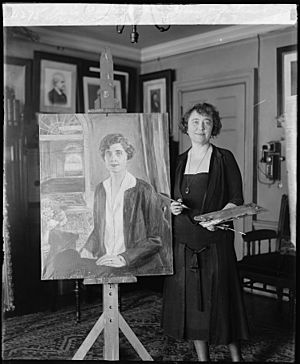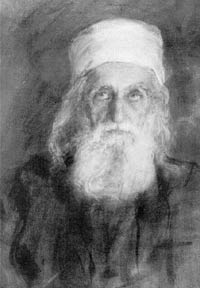Juliet Thompson facts for kids
Juliet Thompson (1873–1956) was an American artist. She was a painter and a follower of Baháʼí Faith leader ʻAbdu'l-Bahá. Many people remember her for her book, The Diary of Juliet Thompson. She also painted a very large portrait of ʻAbdu'l-Bahá.
Contents
Early Life and Art Training
Juliet Thompson was born on September 23, 1873. She was born near Washington, D.C. Her parents, James W. Thompson and Celeste, sent her to the Corcoran School of Art.
When she was 12, her father passed away. He did not leave much money for the family. But Juliet was already good at selling her paintings. She was an active artist in Washington D.C. In 1897, she painted a main artwork for the Cosmos Club annual show.
Her Baháʼí Faith Journey
Around 1898, Juliet learned about the Baháʼí Faith in Washington D.C. She then traveled to Paris. There, she met Thomas Breakwell in 1901. He shared a French description of the execution of the Báb. This helped her feel even stronger in her faith. In Paris, she also took classes about the religion.
ʻAbdu'l-Bahá, the leader of the Baháʼí Faith, visited the United States. He gave a talk at Juliet's home in New York on November 15, 1912. At this meeting, he spoke about the special ideas of the Baháʼí Faith.
During World War I, Juliet gave talks about "The Most Great Peace." This is a Baháʼí idea about a time of global peace. In the 1940s, she made several long trips to Mexico. She went there to share the Baháʼí teachings.
Meeting Other Artists
Juliet Thompson knew Kahlil Gibran, a famous writer and artist. He was her neighbor. She remembered that Gibran met ʻAbdu'l-Bahá a couple of times around 1911-1912.
In 1918, the artist Mark Tobey met Juliet. He posed for her while she painted his portrait. During their time together, Tobey read some Baháʼí literature. He later became a Baháʼí.
Painting ʻAbdu'l-Bahá's Portrait
Juliet met ʻAbdu'l-Bahá in France in 1911. This was during his first trip to the West. Later, during his second trip, he came to New York. For several days starting June 1, 1912, he sat for a life-sized portrait. Juliet painted him.
ʻAbdu'l-Bahá told her, "I want you to paint my servitude to God." This meant he wanted her to show his humble service to God. The original large portrait is now lost. However, there are old photographs of it. A copy of the portrait is kept at the Seat of the Universal House of Justice.
Pilgrimages to Holy Places
Juliet Thompson made two Baháʼí pilgrimages in her life. Her first trip was in July 1909. This is when she started writing her diary. This diary was later published as a book. Her diary is an important source of information. It tells us about ʻAbdu'l-Bahá's travels in Europe in 1911 and in the United States in 1912.
Her second pilgrimage was in 1926.
Later Life and Passing
Juliet Thompson passed away on December 4, 1956. She died at her home in New Rochelle, New York. A memorial service was held for her. It took place at the Baháʼí House of Worship in Wilmette. Many important Baháʼís spoke or sent messages.
Her Art and Paintings
Juliet Thompson's first art show was at the Knoedler's galleries. She worked as a portrait painter for many years. She painted in Washington D.C. and later in New York. She was also interested in other types of art.
Around 1898 to 1900, she studied art in France. She showed her work there. When she returned to the United States, she moved to New York around 1902. She was on the Board of Control for a group called The Pastellists. This group was started in 1910.
Juliet also used her art to help different causes. She supported an early free clinic. She also supported women's right to vote. She helped a project for children living on the streets. And she helped women and children during World War I.
Some of the people she painted portraits of include: Grace Coolidge (a First Lady), and ʻAbdu'l-Bahá.
|



